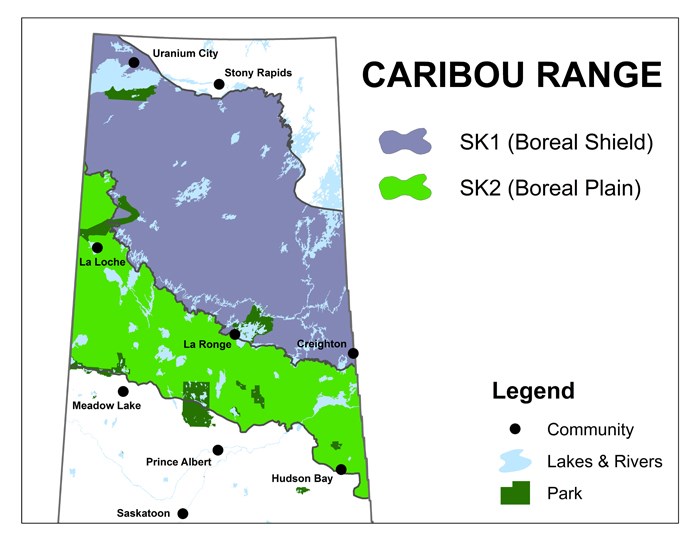Not many Saskatchewan residents can say they have actually seen a woodland caribou in the wild, but these elusive animals are found throughout the forests of Saskatchewan. They are like ghosts in the night as they covertly move around their home range trying to avoid predators.
Woodland caribou are considered to be an important indicator of the health of the boreal forest and their importance to northern communities and our provincial and national identity should not be understated.
With a low reproduction rate, increased human and natural disturbance, and a risk of predators, their population may be facing a decline.
Tim Trottier, a wildlife biologist from the Ministry of Environment’s Fish and Wildlife branch, has studied the animals for many years.
“Woodland caribou are found primarily in the boreal region of Saskatchewan,” Trottier said. “Woodland caribou are larger than deer and smaller than elk. They are grey-brown to chocolate in colour with a white mane. Both sexes have antlers.”
Unlike its cousin, the barren-ground caribou that moves into Saskatchewan from the north only in winter, woodland caribou are found in Saskatchewan year round. They are not migratory, but are always on the move within their home range. Generally, they have ranges about 300 square kilometres, and usually travel in family groups of five to 10 animals, or sometimes alone.
“Woodland caribou prefer mature spruce and pine forests in a mix with treed and open muskegs, ponds and lakes,” Trottier explained. “They tend to avoid pure aspen or similar broadleaf forest stands, and young stands regenerating after logging or fire.”
Wolves are the main predators of woodland caribou. Other predators include black bear, lynx, coyotes and humans. Caribou avoid being located by predators by continuously moving over large distances within forested areas, and not bunching up too much in any one place.
In 2002, woodland caribou were listed as “threatened” under the federal Species At Risk Act, which has resulted in a strategy to sustain the population of the species, led by both the provincial and federal governments.
Federal and Provincial Strategies
Environment Canada released a federal recovery strategy in 2012 based on available caribou habitat and population information assessed within each province.
The federal recovery strategy has identified limits for human-caused or natural habitat disturbance that must not be exceeded in order for caribou populations to be considered self-sustaining. When these limits are exceeded, management measures must be put in place to restore disturbed habitat to maintain or recover woodland caribou populations.
As a result, Saskatchewan’s Ministry of Environment initiated a Woodland Caribou Range Assessment program to help maintain self-sustaining woodland caribou populations within their current range, in an ecologically and economically sustainable way.
Environment Canada identified two caribou conservation units in Saskatchewan – the Boreal Shield and the Boreal Plain.
“Within the Boreal Shield, the province is actively working to better understand the status of the population,” Trottier said. “Within the Boreal Plain, the province is working on the development of range plans that will identify and protect caribou habitat.”
Consultation with First Nations and Métis communities, and continued engagement with northern municipalities, industry and other stakeholders, will be a key component in the development and implementation of these management strategies. This will allow local knowledge, insights, and community perspectives to be woven into the conversation and strategies.
“Range plans are used to help guide future resource management decisions in relation to woodland caribou,” Trottier stated. “These individual plans will reflect the unique population characteristics within the ranges, local issues and concerns, and current and proposed land use.”
They will also look at existing plans, programs and policies, such as forest management plans and environmental assessments.
“We are also collecting information to get a better understanding of the human and natural disturbance patterns on the landscape,” said Trottier, noting that radio-collars have been placed on caribou and wolves in the Cree Lake, Wollaston Lake and Reindeer Lake area to investigate animal movements and habitat use. Caribou scat samples are being analyzed to investigate the genetic makeup of different populations.
Woodland caribou are vulnerable to disturbance from human activities, which can result in the loss of their habitat or create new access into it. Such activities include industrial development, urban development and recreational activities.
Roads, trails, and seismic lines may create access for people and predators to caribou, which can disrupt caribou from feeding and resting, and increase the possibility of predation.
Visit saskatchewan.ca/environment for more information on woodland caribou.



